Bringing Adelaide’s history to colour
The year 2018 marked 30 successful years of the Heritage Incentives Scheme and the City of Adelaide’s commitment to protect, conserve and promote our built heritage.
Since 1988, the City of Adelaide has provided the most substantial local government heritage grant scheme in Australia. Since its inception, the Scheme has provided over $20m in grants to property owners.
In celebration of this achievement, the story of Adelaide’s built heritage is told through a selection of digitally colourised black and white photographs collated in this online exhibition.
Capturing moments in Adelaide’s history over the last two centuries, the photographs have been reimagined in vibrant colour by international colourist Marina Amaral, offering a new and exciting way to view our past.
Famous faces on Pulteney


To the right of this image, part of Ruthven Mansions can be seen.
Built in two stages (1911-1912 and 1914) for R.F. Ruthven Smith Esq, it was the first city apartment building to boast all the mod-cons of the time, including electric lighting and mechanical ventilation.
Among its first residents was Englishwoman Evelyn James (née Marsden), a former stewardess on the Titanic. After the disaster, she married and migrated to Australia.
Built in 1910, the Grand Central Hotel was located at the south-east corner of Rundle and Pulteney Streets until its demolition in 1976. It hosted its own share of significant figures including The Prince of Wales, Sir Arthur Conan Doyle, Mark Twain and The Kinks.
Original source photos: State Library of South Australia, B8519, c.1913
Dancing the night away!


Dance halls hit their peak of popularity in Adelaide in the 1920s and ‘30s.
The busiest in the city were the Floating Palais on the River Torrens and the Palais de Danse (later the Palais Royal), next to Ayers House on North Terrace.
The Palais de Danse, seen here at its opening in April 1920, was the longest running of the city venues.
In September 1920, the weekly program included dancing on Monday, Tuesday, Friday and Saturday nights to music such as the Bubbles Waltz, Kismet Fox-Trot or Oh! Helen One-Step. Twilight Jazz happened Wednesdays and a Fancy-Dress Carnival on Thursdays, with events like a balloon chase offering two prizes of ten shillings.
The band played its last tune in 1967 and the hall was demolished in 1972.
Original photo source: State Library of South Australia, PRG 280/1/28/382, c.1920
A dark day for Adelaide
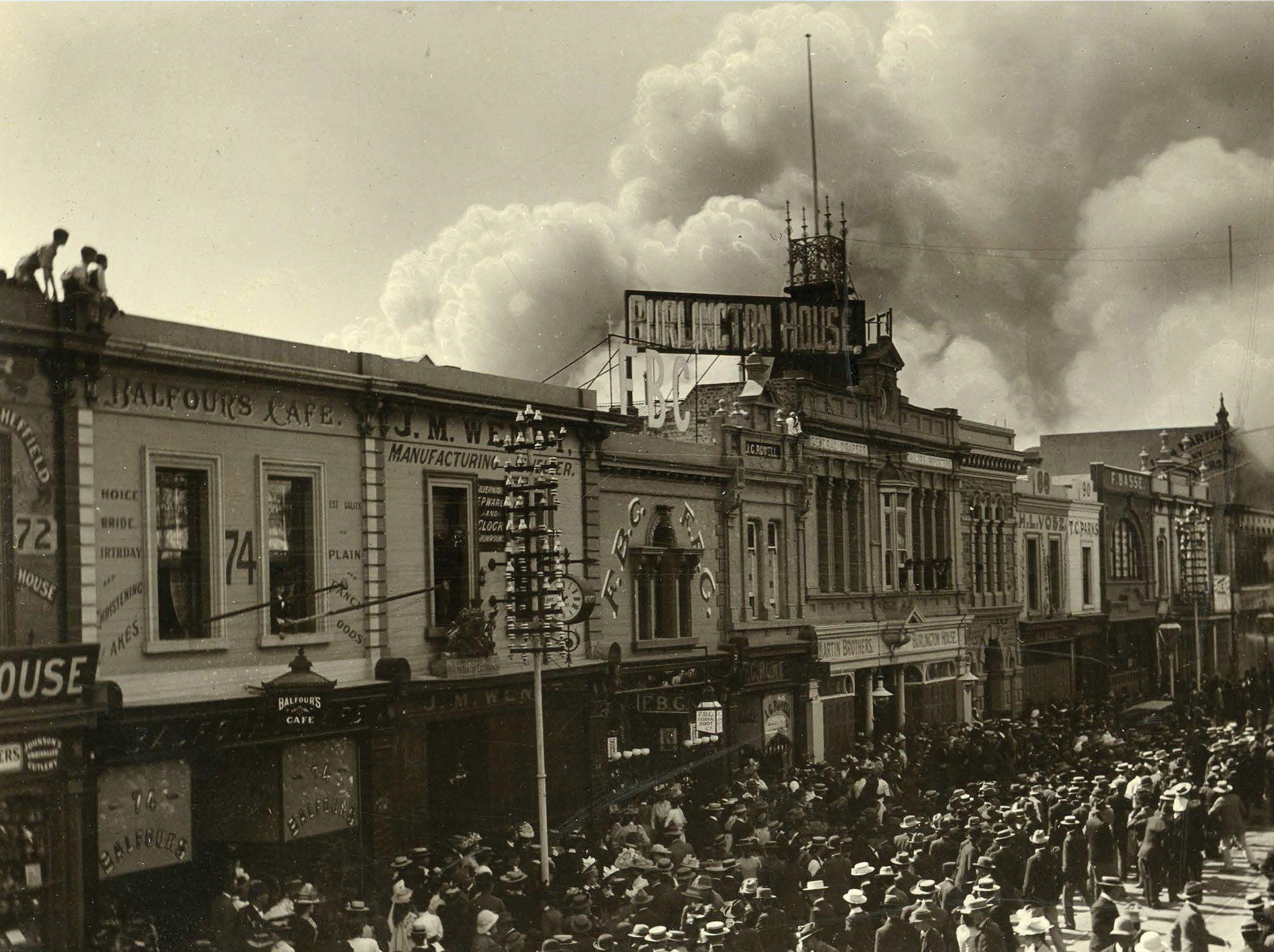

Easter Saturday 1901 was a day that drew thousands into the city, but neither for work nor play.
On the morning of 6 April, fire swept through John Martin’s Rundle Street department store sending plumes of thick smoke into the city sky.
The blaze broke out in a store display window. These were lit by glass gas burners, one of which cracked and set fire to the window decorations.
The evacuation was swift and the first steam fire engine arrived in five minutes. Firemen worked for hours, their only refreshment being drinks brought over by Mrs Balfour from the nearby Balfours Café.
It’s estimated the spectacle drew 10,000 onlookers to Rundle Street and North Terrace.
City Archives, HP0221:01, c.1901
Lights, camera, action!


By the 1920s, Rundle Street was the city’s retail hub by day, but by night, theatre and cinema were the big attractions.
Built for the Greater Wondergraph Theatres chain, the York Theatre opened on the corner of Rundle Street and Gawler Place on 5 November 1921.
Despite its narrow façade, the theatre held 2,000+ people. The side walls of its auditorium were hand-painted by George Coulter with landscapes representing Australasian scenery.
Two American flicks from 1935 were screening at the time of this image: Universal Pictures’ action film Chinatown Squad and The Goose and The Gander - a Warner Brothers’ romantic comedy.
The arrival of television in 1959 saw many theatres close. The York’s final screenings were in 1960, and the building demolished in 1962.
Original photo source: State Library of South Australia, B64013, c.1936
Laying tracks for a new era of travel


In 1878, Adelaide became Australia’s first city to introduce a permanent horse-drawn tram system. Each tram was pulled by two horses and averaged a speed of 8km/h.
Electric trams began operating in 1909, but the Municipal Tramways Trust (MTT) kept horse trams running until 1914 due to the time and money it took to electrify the network.
Mrs Anne Price, wife of the then Premier, drove Electric Tram 1 - under supervision - at the opening ceremony on 9 March 1909.
The MTT’s 1908 administration building and a portion of the old Tram Barns remain on Hackney Road.
While city tram travel stopped in 1958, except the line to Glenelg - it has experienced a renaissance since 2007.
Original photo source: State Library of South Australia, B45883, c.1908
Crowning the glorious Elder Hall


One of North Terrace’s most recognised landmarks, Elder Hall, was named after businessman and pastoralist Sir Thomas Elder and was officially opened on 26 September 1900.
Upon his death, Elder left £65,000 to the University of Adelaide, of which £20,000 was devoted to music. Half was used to establish a Conservatorium of Music, the rest to erect a building to house it.
Designed in the Florentine Gothic style, most of the freestone used in the construction came from Torode’s quarry at Stirling West, although the dressings, quoins and turrets were made of Mount Gambier freestone.
The simplicity of Elder Hall’s exterior belies the splendour inside.
Original photo source: City Archives, HP0084, c.1899
As busy today as it ever was...

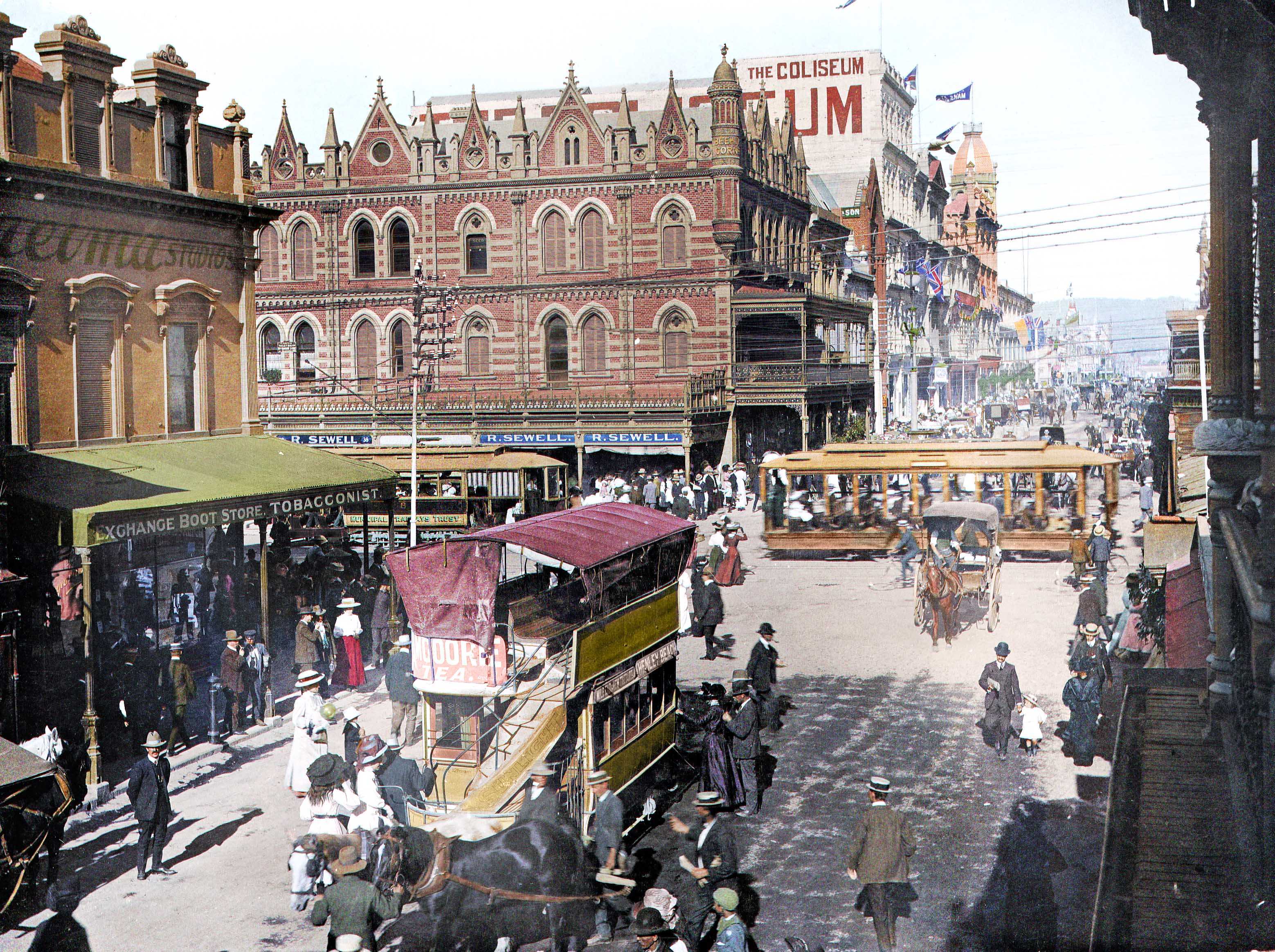
You might think Beehive Corner (Rundle and King William intersection) gets its name solely from the building’s distinct beehive-shaped turret and golden bee, but there’s more to this historic tale.
The first building on the site opened in 1849. A drapery shop called The Beehive was an original occupant, the name reflecting the ‘hive of activity’ in the area.
The building located on this bustling corner today was constructed between 1895-1896, drawing on the Gothic Revival style. It’s been home to Haigh’s Chocolates since 1915 and is one of Adelaide’s most popular and recognised landmarks.
Original photo source: State Library of South Australia, B3532, c.1909
Splish splash at the City Baths


For more than a century, the Adelaide City Baths were a popular spot for locals.
Located on King William Road, behind Parliament House, the baths opened in 1861. Turkish baths were added a few years later, however, it wasn't until 1940 that this outdoor Olympic-size pool and a high-diving platform were installed.
In the 1950s, Olympic swimming coach Harry Gallagher started managing the baths, bringing with him a young swimmer destined for legend status.
Dawn Fraser trained here for her world record-breaking campaign at the 1956 Olympics. Many locals can still recall watching Dawn swim laps - Harry running alongside, stopwatch in hand, urging her on.
Original photo source: City Archives, HP1521, c.1940
On top of the world!


Located on the corner of King William and Hindley Streets, the Romanesque-design Colonial Mutual Life Building (now the Mayfair) is an iconic city structure.
Built in 1934 to the legally permissible height at that time, it remained Adelaide’s tallest building for over three decades.
During construction Adelaide was still suffering the effects of the Great Depression, so labour was abundant and the build took just nine months to complete.
The material used in the façade - including the adorning lions, gargoyles and vultures - is a notable feature. Benedict Stone was created from crushed porphyry and blended into a mixture that could be poured and set in moulds, similar to concrete.
It never became popular so examples of its use are few.
Original photo source: State Library of South Australia, B43967/101, c.1934
Spooky tales


Running between Rundle Mall and Grenfell Street, Adelaide Arcade opened on 12 December 1885 - an orchestral performance of The Adelaide Arcade Polka marking the occasion.
One of 50 shops, the lavish Turkish Baths in the south-eastern corner were a particularly exotic feature - with warm baths offered for a shilling.
Adelaide Arcade was one of the first city buildings with electric lighting - a feature which pops up in tales of its resident ghost! In 1887, caretaker Francis Cluney was investigating a flickering light when he fell into an electrical generator and died. Since then, there have been intermittent reports of sightings, strange footsteps, objects being moved and other peculiar activity.
Original photo source: State Library of South Australia, B7496, c.1886
Cheers to our grand old pubs!


Hotels have long contributed to the character of the city. In fact, Adelaide has always had more pubs than churches.
Over the years, nine pubs have existed along what’s now Rundle Mall. This image shows the Hamburg Hotel on the south-east corner of Rundle Street and Gawler Place. It was replaced by the Oriental Hotel, now known as the Walsh Building.
Pub trivia:
- In the early days, beer was served flat, strong and warm.
- Introduced during WWI (1916), pubs closed at 6pm creating the infamous ‘6 o’clock swill’. This remained in SA until 1967!
- One theory of the uniquely South Australian ‘butcher’ glass, holding 200ml (7 fl. oz), is it was once a favourite of abattoir workers patronising the city’s historic Newmarket Hotel.
Original photo source: State Library of South Australia, PRG 631/2/1288, c.1909
Flags fly for troops


The Boer War (11 October 1899 - 31 May 1902) was the first in which South Australians fought overseas and local women served as nurses.
The building to the left of this image, its balcony packed with onlookers, has its own story to tell. In 1857, William Kither Snr took over a butchery established on this site a year prior. His son, William Jnr, succeeded him - becoming known as the knight of the cleaver’.
By 1880, this Italian Renaissance style building had replaced the old shop. The new premises garnered much attention when the South Australian Electric Company introduced the first commercial lighting in Adelaide there in 1882. Crowds of onlookers gathered between six and eleven o’clock.
State Library of South Australia, PRG 631/2/1813, c.1900
The first food trucks

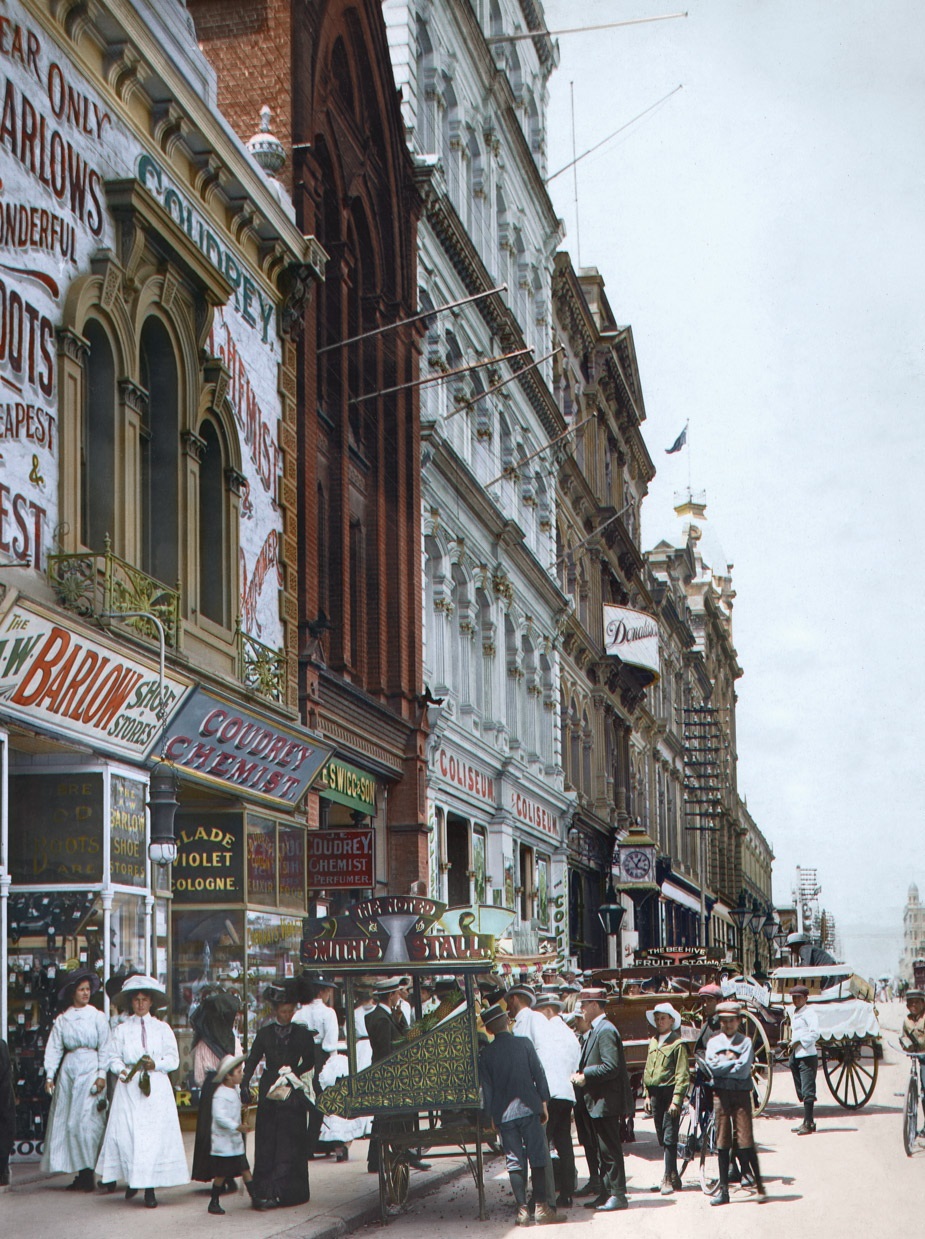
Plying fruit, flowers, ice creams, cool drinks, newspapers and magazines - Adelaide Hawkers Stands date back to the 1850s-1860s.
They ran from specific sites across the city, later numbered and marked by cast iron plates in the kerb. One pair of plates still exist on Frome Street, outside the Adelaide Zoo. Pie carts also featured on Adelaide’s streets in the early years.
The first was located at the corner of Franklin and King William Streets, near the GPO.
In 1884, English immigrant J. Gibbs opened a pie stall for workers after a low-cost, wholesome meal. It took Gibbs six years to save for the venture. Initially he couldn’t afford a horse to pull the cart, so nightly he’d push it himself from Waymouth Street to the corner of Rundle and King William Streets where he traded.
Original photo source: City Archives, HP1793, c.1900-1910
The story of Stephens Place
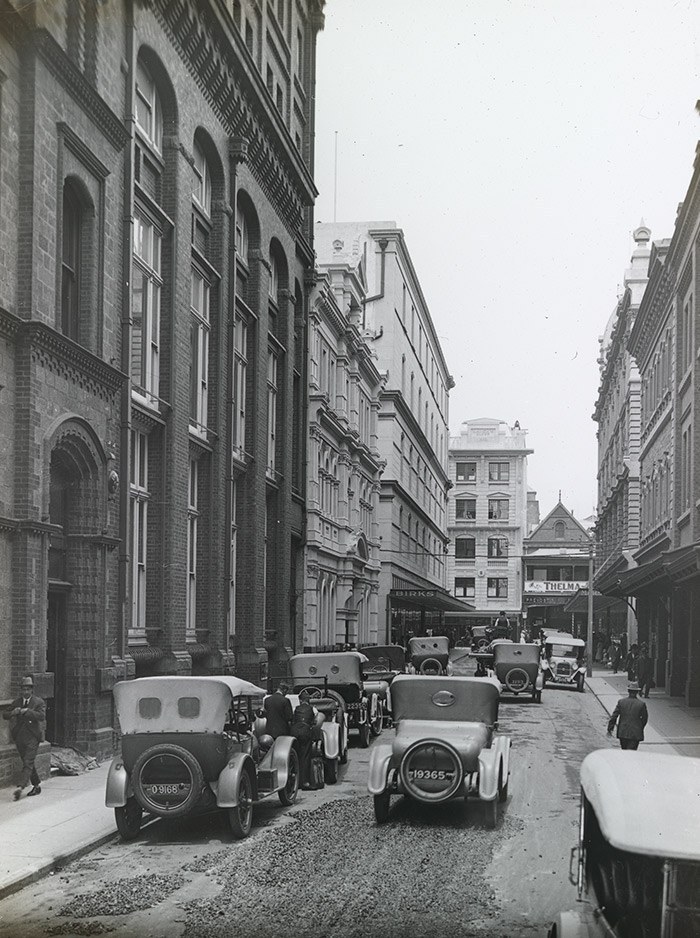
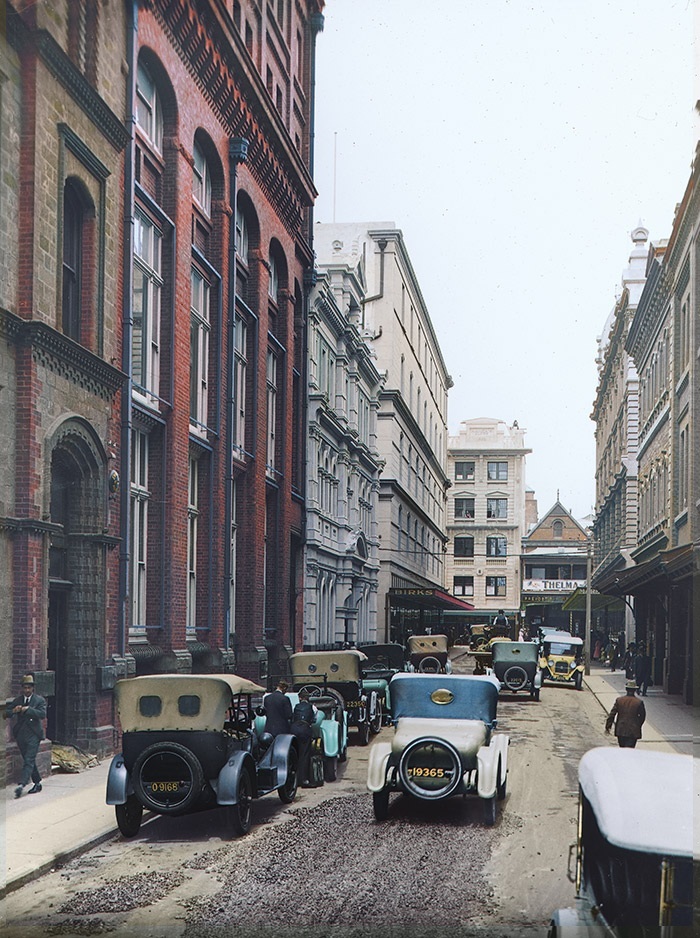
Linking North Terrace to Rundle Mall, this narrow street was named after Edward Stephens, manager of South Australia’s first bank and member of the City’s Street-Naming Committee which decided the names of Adelaide’s streets and squares.
The colony’s Surveyor-General, Colonel William Light, selected the site for Adelaide and finalised the city’s layout. In 1837, he and George Kingston published a map showing numbered Town Acres and the named major thoroughfares. As the acres were sold, sub-divided and developed, streets like this one were created.
At the end of Stephens Place is Garko House (formerly Haigh’s Building) - built in 1923 for A.E. Haigh, founder of Haigh’s Chocolates.
Original photo source: City Archives, LS0647, c.1923
Delivery of the mighty Wurlitzer


Described as a “Palace of Art” on its opening day (29 June 1928), the Regent Theatre made going to the pictures a special occasion.
Tapestries, paintings and other artworks adorned the interior and the ushers and usherettes dressed in military-style uniforms. The auditorium seated 2,300 with a highly-arched proscenium the focal point. A huge crystal chandelier hung above the lounge circle.
Filling the theatre with music was the famous Wurlitzer pipe organ, seen here arriving at the venue three months after the opening. Costing £25,000, it premiered on 22 September 1928 with American Ray de Clemens at the keys.
Theatre audiences dwindled from 1959 and in 1967, plans were drawn up to create an arcade in the stalls area. The theatre closed in 2004, but Regent Arcade remains a popular retail destination.
Original photo source: State Library of South Australia, B4845, c.1928